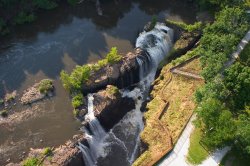The Main Points
- Like conductivity and salinity, dissolved oxygen is an important tool for assessing water quality.
- Because of the variability of dissolved oxygen measurements with depth, distance, time and temperature, multiple measurements may be required to obtain enough data to make effective environmental management decisions.
The Details
Rivers, lakes and streams obtain oxygen from the atmosphere and from aquatic plants as a result of photosynthesis. Rivers, lakes and streams loose oxygen due to processes, such as respiration by aquatic plants and animals, decomposition of organic matter, and chemical reactions that consume oxygen.
Oxygen is essential for fish and other aquatic plants and animals, and therefore it is one of the most important measurements to determine the overall health of a water body.
Oxygen is measured in its dissolved form as dissolved oxygen (DO). The results of this measurement are usually expressed as milligrams of dissolved oxygen per liter of water (mg/L, parts per million, or ppm).
DO results are sometimes reported as the percent saturation. The amount of any gas that can be dissolved in water depends on the water temperature. Colder waters can hold more dissolved gas and warmer waters hold less. The theoretical maximum amount of oxygen that any body of water can hold at a given temperature is called 100% saturation. So if water can hold a theoretical maximum of 10 parts per million of oxygen at 20°C, and the actual concentration is only 8 parts per million, the percent saturation is 80% (8/10).
The amount of dissolved oxygen determines the types of aquatic animals that can live in the water. Brown trout living in a free-flowing stream thrive when the DO concentration is between 9 and 12 mg/L. Catfish can live in water with as little as 5 mg/L of DO. However, most cold water fish require a minimum of 4-6 mg/L of DO to survive while some species of fish can live in water with only 2.5 to 3 mg/L DO before showing signs of stress.
One of the most important causes of DO reduction is the decomposition of organic matter. Normally, leaves and other plant debris fall into a lake and are eaten by bacteria. Like all other animals, bacteria need oxygen to survive. When the rate of oxygen consumption by bacteria (and other plants and animals) is less than oxygen inputs through photosynthesis and diffusion, the lake or river remains healthy. After an algae bloom, the rate of bacterial decomposition is so high that the water body no longer contains enough oxygen to support life in the bottom sediments. In extreme cases there may also be a fish kill due to low DO in the water. This is likely to happen at small to medium size lakes with high nutrient contents during hot summer months.
Because the amount of oxygen is closely related to the overall health of a lake, it is important to understand the trophic state of a waterbody. Trophic states of waterbodies include the following:
Oligotrophic: Low productivity. For example, larger, deeper lakes with clear water, rocky or sandy shorelines, limited rooted plant growth, low algal growth and adequate dissolved oxygen throughout.
Mesotrophic: Medium productivity. An intermediate category with characteristics between the other two groups.
Eutrophic: Highly productive. For example, smaller, shallower ponds with mucky bottoms, extensive alga, extensive plant growth and depleted dissolved oxygen in the bottom waters.
Human sources of oxygen-depleting organic materials include stormwater runoff from farmland or urban streets, feedlots and failing septic systems. Thermal pollution such as cooling water from a manufacturing or a power plant will also raise the temperature of water and lower its oxygen content.
